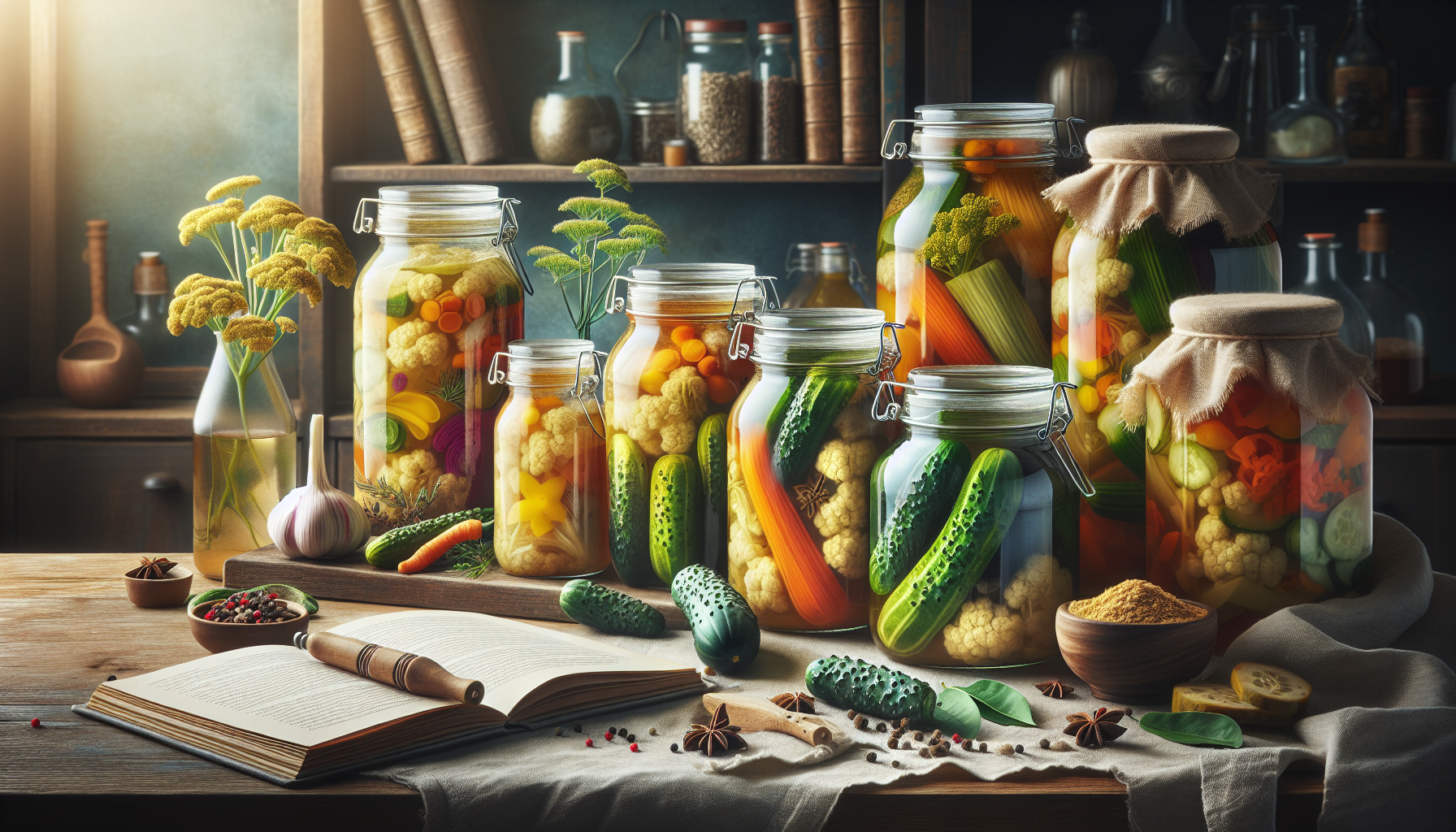In a world where culinary traditions and health-conscious choices intersect, the art of fermentation stands out as a remarkable synthesis of flavor enhancement and nutritional enrichment. Imagine unlocking the potential of your kitchen to create vibrant, probiotic-rich foods that delight the senses and fortify your well-being. At the heart of this transformative journey lies the humble yet powerful fermentation crock. These vessels, steeped in history and innovation, serve as the essential tool for anyone eager to delve into the rich world of fermented foods. From the tangy allure of homemade sauerkraut to the complex depths of miso, fermentation crocks are the gateway to both timeless flavors and modern wellness benefits.
As we navigate through this article, we will explore the multifaceted wonders of fermentation crocks, highlighting how they enhance both the taste and nutritional value of your food. We’ll delve into the science behind fermentation, unraveling how this ancient process not only preserves but also elevates the nutritional profile of ingredients. Furthermore, we’ll discuss the diverse range of foods that can be crafted within these crocks, each offering unique flavors and health advantages. Whether you’re a seasoned fermenter or a curious novice, understanding the nuances of choosing the right crock can be the key to unlocking a world of culinary possibilities.
Join us as we embark on a journey to discover how top-quality fermentation crocks can transform your cooking repertoire and elevate your health. We will guide you through the selection process, providing insights into what makes a crock not only effective but also user-friendly. Additionally, we’ll share tips and tricks for getting started, ensuring that your fermentation endeavors are both successful and enjoyable. By the end of this article, you’ll be equipped with the knowledge and inspiration needed to turn simple ingredients into extraordinary creations that nourish both body and soul. So, let’s dive into the world of fermentation and unlock the hidden treasures within your kitchen, one crock at a time! 🍶🌿
The Ancient Art of Fermentation: A Timeless Culinary Practice
Fermentation is an ancient culinary technique that has been utilized for thousands of years across various cultures. This age-old process involves the transformation of food through the activity of microorganisms such as bacteria, yeast, and molds. Fermentation not only enhances the flavor and texture of foods but also boosts their nutritional profile, making it a staple in traditional diets worldwide. The art of fermentation offers a remarkable blend of science and creativity, allowing culinary enthusiasts to explore a vast array of tastes and health benefits.
Fermentation transforms ordinary ingredients into extraordinary culinary creations. From tangy sauerkraut to effervescent kombucha, fermented foods are known for their unique flavors and probiotic content, which supports gut health. As people become more health-conscious, there is a growing interest in rediscovering and mastering this ancient art. With the right tools, such as high-quality fermentation crocks, anyone can unlock the secrets of fermentation and elevate their culinary repertoire.
The history of fermentation is as diverse as the foods it produces. Cultures around the world have harnessed the power of fermentation to preserve food and enhance its flavors. The process is simple yet profound: microorganisms consume sugars and starches, producing by-products such as lactic acid, alcohol, and acetic acid, which not only preserve the food but also give it distinct flavors. Fermented foods are rich in probiotics, which are beneficial bacteria that aid in digestion and promote a healthy gut microbiome.
Choosing the Right Fermentation Crock: A Guide to Making the Best Choice
When it comes to fermenting your own foods at home, choosing the right fermentation crock is crucial. A good crock can significantly impact the quality and success of your fermentation process. Fermentation crocks come in various shapes, sizes, and materials, each offering distinct advantages and challenges. Here’s what you need to consider when selecting a fermentation crock.
The material of the crock is one of the most important factors. Common materials include ceramic, glass, and plastic. Ceramic crocks are traditional and preferred for their ability to maintain consistent temperatures and block light, which can adversely affect the fermentation process. Glass crocks, on the other hand, allow you to monitor the progress of your fermentation visually, although they may not provide the same level of protection from light. Plastic crocks are lightweight and less expensive but may absorb odors and stains over time, which could affect the taste of your ferment.
| Material | Advantages | Disadvantages |
|---|---|---|
| Ceramic | Retains temperature well, blocks light, traditional look | Heavy, can be expensive |
| Glass | Allows visual monitoring, non-reactive | Does not block light, can be fragile |
| Plastic | Lightweight, inexpensive | Can absorb odors, may stain |
Health Benefits of Fermented Foods: Beyond Flavor Enhancement
Fermented foods are not only celebrated for their unique flavors and textures but also for their impressive health benefits. Consuming fermented foods can significantly contribute to gut health, enhance nutrient absorption, and boost the immune system. The fermentation process naturally enriches foods with probiotics, beneficial bacteria that aid in maintaining a balanced gut microbiome.
The gut microbiome plays a critical role in overall health, influencing everything from digestion to mental health. Probiotics from fermented foods can help restore the balance of gut bacteria, especially after disruptions caused by factors like antibiotics or poor diet. Fermented foods also tend to be easier to digest, as the fermentation process breaks down complex carbohydrates and proteins, making nutrients more accessible to the body.
In addition to probiotics, fermented foods are often rich in vitamins, minerals, and antioxidants. For example, sauerkraut is an excellent source of vitamin C and vitamin K, while miso provides a good dose of B vitamins. Moreover, some fermentation processes can increase the bioavailability of nutrients, meaning your body can absorb them more efficiently. Incorporating a variety of fermented foods into your diet can therefore enhance both flavor and nutrition.
Explore Further
- Watch a detailed explanation of fermentation on YouTube – Fermentation Explained (Khan Academy).
- Check out our table above for a quick comparison of different fermentation crock materials.
- Consider starting your fermentation journey with a small ceramic crock for optimal results.

Conclusion
In conclusion, the art of fermentation is a timeless and transformative process that offers a multitude of benefits, both in terms of flavor enhancement and health improvements. Throughout this article, we have explored the myriad ways in which fermentation can elevate your culinary experiences and contribute to your overall well-being. From the historical roots of fermentation to its modern-day applications, we’ve seen how this ancient technique continues to hold relevance in our kitchens and our lives.
One of the key points discussed is the role of fermentation in enhancing the flavor profile of foods. Fermented products like sauerkraut, kimchi, and kombucha are celebrated for their rich, complex flavors that develop through the careful and controlled process of fermentation. These flavors are not only unique and delightful but also indicative of the craftsmanship involved in creating fermented foods. By using high-quality fermentation crocks, home fermenters can achieve consistent and delicious results, transforming ordinary ingredients into extraordinary culinary creations.
Moreover, the health benefits associated with fermented foods cannot be overstated. Fermentation is a natural preservation method that not only extends the shelf life of foods but also enhances their nutritional value. Fermented foods are rich in probiotics, which are beneficial bacteria that support gut health and boost the immune system. Regular consumption of fermented foods can lead to improved digestion, increased nutrient absorption, and a balanced gut microbiome. These benefits highlight the importance of incorporating fermented foods into our diets, not just for their taste but for their profound impact on our health.
Additionally, fermentation is an environmentally friendly process that promotes sustainability. By fermenting at home, individuals can reduce food waste, as fermentation allows for the utilization of surplus produce and leftovers. This practice aligns with the growing trend of sustainable living and conscious consumption, making fermentation a valuable addition to any eco-conscious kitchen.
As we conclude our exploration of fermentation, it is essential to recognize the accessibility and versatility of this practice. With the right tools, such as our top-quality fermentation crocks, anyone can embark on a fermentation journey, regardless of their culinary expertise. These crocks are designed to provide the perfect environment for fermentation, ensuring consistent and successful results every time.
We encourage you, our readers, to embrace the art of fermentation and experiment with different ingredients and recipes. Whether you are a seasoned fermenter or a curious beginner, there is always something new to discover in the world of fermentation. Share your creations with friends and family, and spread the joy and benefits of fermented foods. By doing so, you contribute to a community of food enthusiasts who value tradition, health, and sustainability.
In today’s fast-paced world, taking the time to engage in fermentation can be a rewarding and therapeutic experience. It allows us to connect with the food we eat, understand its origins, and appreciate the processes that transform it. Fermentation is more than just a culinary technique; it is a celebration of nature’s ingenuity and our ability to harness it for nourishment and pleasure.
We invite you to join the fermentation movement and explore the endless possibilities it offers. Comment below to share your thoughts and experiences with fermentation, or reach out with any questions you may have. Don’t forget to share this article with others who might be interested in unlocking the art of fermentation. Together, we can inspire a greater appreciation for this ancient practice and its modern-day relevance.
For further reading and resources on fermentation, we recommend visiting reputable sources such as the National Center for Home Food Preservation and Kombucha Brewers International, which offer comprehensive guides and research on the subject. Let’s continue to learn, create, and enjoy the incredible benefits that fermentation brings to our lives! 🌿
—
*Note: Please verify the availability and content of the links provided, as online resources may change over time.*
Toni Santos is a visual chronicler and historical researcher who explores the lost language of healing through forgotten instruments and ancient medical design. With a delicate blend of curiosity and reverence, Toni uncovers the mysterious tools once used in temples, apothecaries, and folk practices—objects that echo a time when healing was both art and ritual.
Rooted in a fascination with the intersection of medicine, myth, and craftsmanship, his work traces how past civilizations understood the body, spirit, and cosmos through tools now obscured by time. From vibrational tuning forks and herbal infusion vessels to symbolic scalpels carved with protective motifs, Toni’s visual storytelling gives new life to the technologies that once held deep cultural and curative power.
With a background in historical illustration and material culture, Toni reconstructs these instruments with artistic precision—offering not just images, but narratives that reveal the beliefs, fears, and hopes embedded in the tools of care.
As the visionary behind Vizovex, Toni shares curated archives, interpretive essays, and artifact-inspired artworks that help audiences reconnect with the ancestral roots of healing and the poetic devices once used to restore balance.
His work is a tribute to:
The craftsmanship of early healing technologies
The spiritual symbolism behind medical instruments
The intimate connection between body, tool, and ritual
Whether you’re an enthusiast of forgotten sciences, a student of holistic traditions, or a seeker of the obscure, Toni welcomes you into a world where healing was sacred, and every tool told a story—one wound, one charm, one cure at a time.





